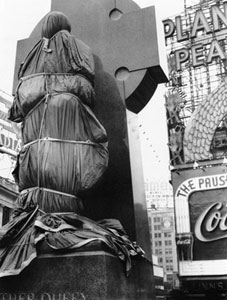Berenice Abbott Cities Portraits
Berenice Abbott Cities Portraits
Photographs by Berenice Abbott, on view at the University of Maine Museum of Art in Bangor from June 25 through September 18, 2004, highlight two major phases of this renowned photographer’s career. Berenice Abbott was one of the most accomplished documentary photographers of the 20th century as well as a prolific writer, teacher, and inventor. It was while working for Man Ray in Paris during the 1920s that Abbott first started working in photography. She made portraits during this time and continued to do so in New York City during the early 1930s. Abbott always allowed her sitters to relax and become comfortable in their surroundings before she captured their image, creating honest, straightforward photographs. Her portraits have proven to be true documents of the personalities of this era, still serving historians and scholars of the period.
The second focus of this exhibition is on Abbott’s photographs of New York City, taken during the 1930s when the city was undergoing massive change and becoming a leading metropolis virtually overnight. Working under the Federal Art Project, part of the Works Progress Administration, Abbott combed the streets of Manhattan, Brooklyn, and the Bronx, searching for change and the contrasts and contradictions brought on by it. The Changing New York photographs, like her portraits, capture the spirit of the age. Through her unique vision this project documented the changing face of the city. In 1939, she wrote that she had intended “…to preserve for the future an accurate and faithful chronicle in photographs of the changing aspect of the world’s greatest metropolis…while remaining true to its essential fact, its hurrying tempo, its congested streets, the past jostling the present.”
Berenice Abbott was born in Springfield, Ohio in 1898, and lived in Europe, Cambridge, and New York City before retiring in Abbot Village, Maine in the 1960s. After the Changing New York series, her photographic subject matter broadened to include scientific phenomena, particularly physical and chemical reactions. This led her to work at MIT for a number of years where she produced images for textbooks. American landscapes also continued to be a source of inspiration: in 1954 Abbott traveled U.S. Route 1 from Florida to Maine, photographing small towns encountered along the way. When she settled in Maine in the 1960s, the state and its people became her photographic focus. Abbott also invented new equipment and techniques for photography, receiving four U.S. patents and several honorary doctorates. Her work has been exhibited widely, including many one-person shows and retrospective exhibitions.

Father Duffy Times Square, 1937
Gelatin silver print
